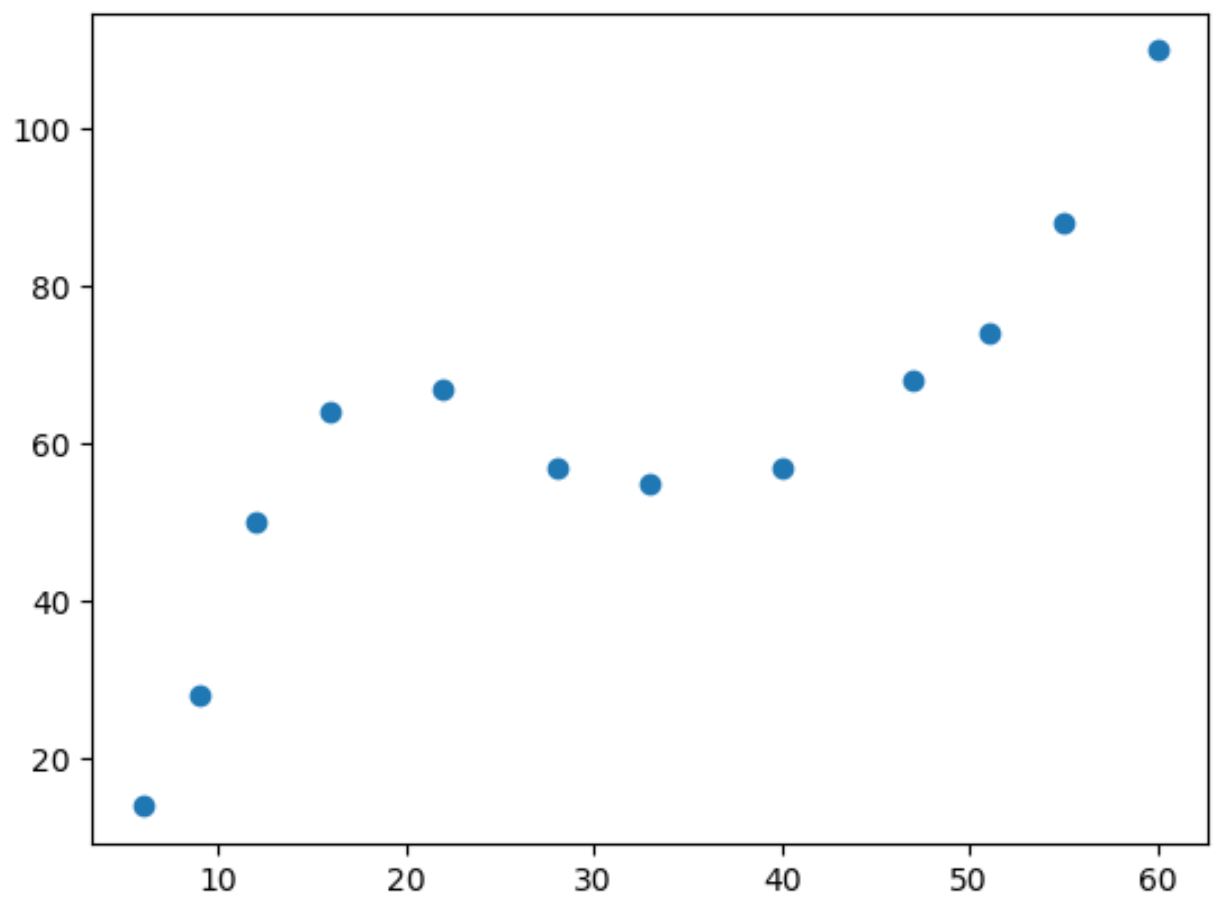如何在 python 中执行三次回归
三次回归是一种回归类型,当变量之间的关系是非线性时,我们可以使用它来量化预测变量和响应变量之间的关系。
本教程介绍如何在 Python 中执行三次回归。
示例:Python 中的三次回归
假设我们有以下 pandas DataFrame,其中包含两个变量(x 和 y):
import pandas as pd #createDataFrame df = pd. DataFrame ({' x ': [6, 9, 12, 16, 22, 28, 33, 40, 47, 51, 55, 60], ' y ': [14, 28, 50, 64, 67, 57, 55, 57, 68, 74, 88, 110]}) #view DataFrame print (df) xy 0 6 14 1 9 28 2 12 50 3 16 64 4 22 67 5 28 57 6 33 55 7 40 57 8 47 68 9 51 74 10 55 88 11 60 110
如果我们对这些数据制作一个简单的散点图,我们可以看到两个变量之间的关系是非线性的:
import matplotlib. pyplot as plt
#create scatterplot
plt. scatter (df. x , df. y )

随着 x 值的增加,y 增加到某个点,然后减少,然后再次增加。
图中具有两条“曲线”的模式表明两个变量之间存在立方关系。
这意味着三次回归模型是量化两个变量之间关系的良好候选模型。
要执行三次回归,我们可以使用numpy.polyfit()函数拟合 3 次多项式回归模型:
import numpy as np #fit cubic regression model model = np. poly1d (np. polyfit (df. x , df. y , 3)) #add fitted cubic regression line to scatterplot polyline = np. linspace (1, 60, 50) plt. scatter (df. x , df. y ) plt. plot (polyline, model(polyline)) #add axis labels plt. xlabel (' x ') plt. ylabel (' y ') #displayplot plt. show ()

我们可以通过打印模型系数得到拟合的三次回归方程:
print (model)
3 2
0.003302x - 0.3214x + 9.832x - 32.01
拟合的三次回归方程为:
y = 0.003302(x) 3 – 0.3214(x) 2 + 9.832x – 30.01
我们可以使用这个方程根据 x 的值计算 y 的期望值。
例如,如果 x 为 30,则 y 的预期值为 64.844:
y = 0.003302(30) 3 – 0.3214(30) 2 + 9.832(30) – 30.01 = 64.844
我们还可以编写一个简短的函数来获取模型的 R 平方,它是响应变量中可以由预测变量解释的方差的比例。
#define function to calculate r-squared def polyfit(x, y, degree): results = {} coeffs = np. polyfit (x, y, degree) p = np. poly1d (coeffs) #calculate r-squared yhat = p(x) ybar = np. sum (y)/len(y) ssreg = np. sum ((yhat-ybar) ** 2) sstot = np. sum ((y - ybar) ** 2) results[' r_squared '] = ssreg / sstot return results #find r-squared of polynomial model with degree = 3 polyfit(df. x , df. y , 3) {'r_squared': 0.9632469890057967}
在此示例中,模型的 R 方为0.9632 。
这意味着响应变量中 96.32% 的变异可以由预测变量来解释。
由于这个值如此之高,它告诉我们三次回归模型很好地量化了两个变量之间的关系。
相关:什么是好的 R 平方值?
其他资源
以下教程解释了如何在 Python 中执行其他常见任务: